Aftershokz Trekz Titanium Review
Aftershokz Trekz Titanium
Headphones for cycling safely
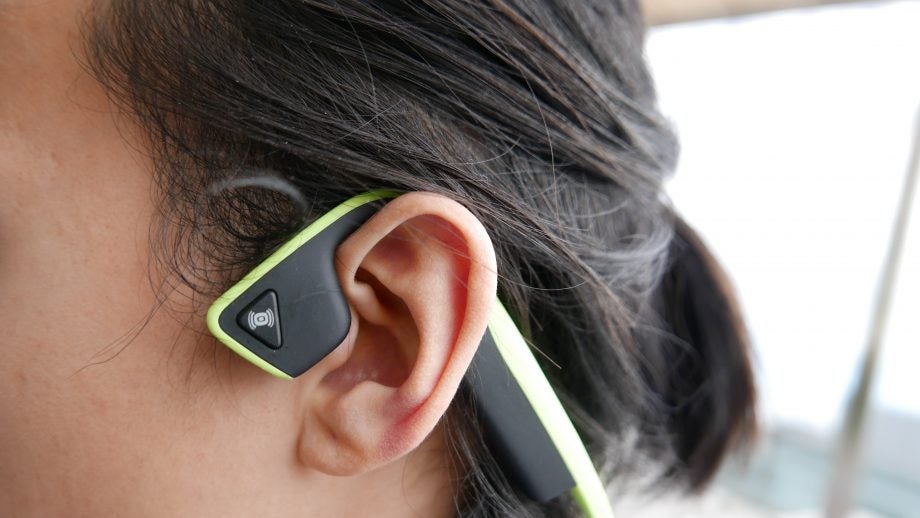
Verdict
Pros
- Bone conduction works well
- Great level of situational awareness
- Reasonable battery life
Cons
- Slightly uncomfortable after prolonged used
- Sound leakage
- Lacklustre sound quality
Key Specifications
- Review Price: £109.99
- Bone conduction technology
- Bluetooth 4.1
- IP55 rating
- Dual noise-cancelling microphones
What are the Aftershokz Trekz Titanium?
Cycling while wearing headphones isn’t advised. Yet everyday, in the city especially, chances are you’ll encounter at least a few cyclists wearing either in-ears or over-ear cans in place of a helmet. Road safety be damned.
The reason headphones aren’t a good idea is that they hinder your awareness of traffic around you. It’s the same reason some runners prefer non-isolating headphones.
The Aftershokz Trekz Titanium avoid shutting you off from the outside world by using a technology called “bone conduction”. This sends vibrations through your cheekbones, where the sound is then processed in your inner ear. It means your ears are still free to hear the outside world, such as that terrifying taxi hurtling by at 50mph in a 30mph zone.
It is this ability to retain situational awareness that makes the Aftershokz Trekz Titanium a considerably safer option if you must have music and audio while cycling or running – even if their actual sound quality is far from stellar.
Watch: Trusted Explains – What type of headphones should I buy?
Aftershokz Trekz Titanium – Design and comfort
On the surface, the Trekz Titanium resemble a normal pair of wireless neckband-style headphones. The neckband itself is made from a titanium alloy, hence their name. The rubber-coated titanium frame is lightweight and feels robust.
I found the rigid neckband became a tad uncomfortable to wear after long periods. In particular, the part that rests over the top of your ears and against the rear of your head could do with being softer. My ears and skull began to feel ever-so-slightly bruised. Everyone’s head is different, so your experience might be better or worse.
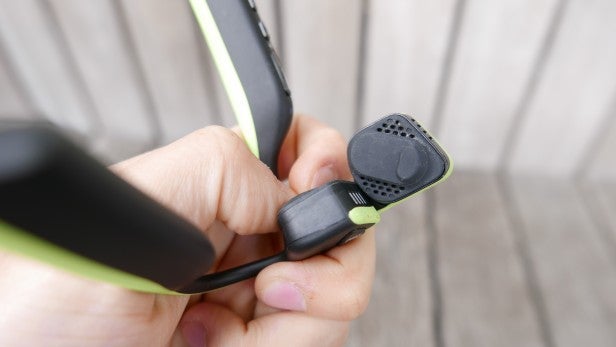
The headphones are rated to IP55, which equates to basic dust- and water-resistance. You shouldn’t have any problems wearing these in the rain, and they can happily cope with a bit of sweat. The Trekz Titanium are available in either blue, green or grey finishes.
It’s only on closer inspection, in particular where you’d normally find earbuds, that the difference between the Trekz Titanium and conventional earphones becomes apparent. Instead of having tips that are inserted into your ear canal, these sit in front of your ears, resting against the side of your skull.
Behind your ear, towards the right bone conduction transducer, you’ll find a volume up button that also serves as a power button and a volume down button. Next to these sit a Micro USB port for charging the headphones.
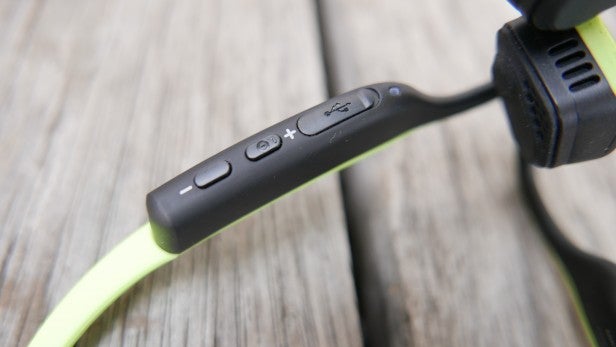
I’d have preferred the charging point to be located on the left-hand side, since the right feels cluttered. In addition, the rubber flap that covers the Micro USB point feels very much like the volume buttons when you’re blindly fumbling for the controls.
On the outside of the right bone conduction transducer you’ll find the multi-function button. With it you can play and pause tracks, answer and reject calls, and activate Siri or Google Now voice commands.
You can also double-press it to skip a track – yet, confusingly, there’s no option to skip back a track with a triple-press, which is a standard inclusion on most headphones.
There are dual noise-cancelling microphones for hands-free calling. These proved to work great. Callers could hear my voice clearly – even while I was cycling – and they came through loud and clear, too.
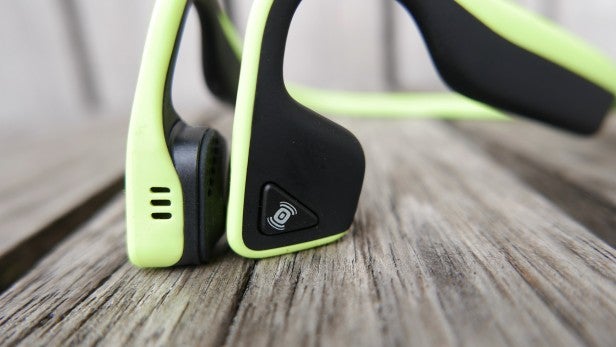
If you’re planning on wearing these whilst cycling, your experience might vary depending on what type of helmet you wear. You might find that your helmet straps get in the way, so the headphones may have to go on last.
In the box, along with the headphones, you get a transportation pouch and fitbands for adjusting the size. These will be necessary for anyone with a smaller head to ensure a tight enough fit for the bone conduction to work effectively.
Aftershokz Trekz Titanium – Bone conduction and sound quality
Trying on a pair of bone conduction headphones for the first time can be a strange experience. With the volume cranked up, the sensation of vibrations against the side of your head are quite pronounced. I’ve given the Trekz Titanium to friends and acquaintances to try, and they all describe the initial experience as “like having the side of your head tickled”.
You’ll soon get used to it and forget about it – plus, it’s less pronounced at lower volumes. Having the audio produced inside your skull can also feel a little alien. There’s a sense of soundstage that you’re probably not used to, and the strange feeling that you can’t quite place where the music is coming from.
Eventually you just get used to it and the headphones will feel like any other.
Related: Best headphones for running round-up
As for ambient sound, with your ear canal not obstructed, you’re free to hear everything around you – provided the volume of your audio isn’t turned all the way up.
I didn’t have any problems hearing traffic whilst cycling, running or just walking through the city. A double-decker bus could easily be heard on approach from behind me to passing alongside. Sat in an office environment, I could hear all of the conversations and crunching of food from colleagues – for better or for worse.
With your ears exposed you’ll have to contend with some wind noise when cycling or running, but in my experience, it never proved too distracting.
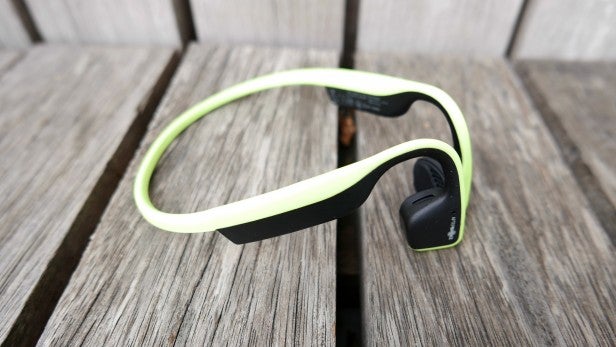
The sound produced can be rather thin in the treble, with flabby bass and lacking any real energy or drive. It’s all a little uninspiring and flat, really. These aren’t headphones you’ll want to wear for everyday listening.
In the context of listening during a cycling commute the tuning is understandable, since the bright treble will be more easily heard over traffic. There’s a secondary EQ mode accessible by holding both volume buttons that reduces the bass and the vibrations further. These headphones actually excel at audiobooks and podcasts.
One issue with the Trekz Titanium is that the sound leakage is high. This is despite Aftershokz’s claimed “LeakSlayer” technology that’s meant to dampen it. With the volume turned up, people around you will be subject to your music. If Aqua’s “Barbie Girl” is your morning jam, the world will know.
At first I wasn’t entirely sure how much of the sound I was hearing was actually being conducted through my skull, and how much of it was from just simply having a speaker in the vicinity of my ear. To test this, I stuck my fingers in my ear, blocking out the ambient sound. Lo and behold, the audio from the Trekz Titanium continued to play inside my head.
So there is indeed conduction happening, but you still need to be aware of the sound leakage. If you’re planning to wear these headphones outdoors while running or cycling they should be absolutely fine. Turn them up in an office environment and you’ll eventually annoy everyone around you.
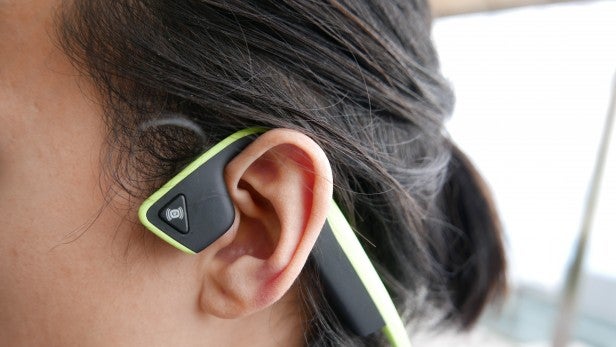
A pair of conventional earplugs is included in the box, similar to the type you can purchase in the airport. These are for when you don’t want to hear ambient sound – but at this point I wouldn’t choose to wear the Trekz Titanium due to the sound quality and the leakage. For me, these headphones are purely for sporty endeavours and commuting.
The Trekz Titanium pair with your audio source over Bluetooth 4.1, and I didn’t encounter any problems with the wireless reliability. Range is rated at a standard 10 metres.
Aftershokz Trekz Titanium – Battery Life
Battery life is rated at six hours of continuous listening, which is reasonable. Other bone conduction headphones on the market boast more, but they’re often heavier and more unwieldy in order to accommodate a bigger battery. In my opinion, six hours is a decent trade-off. There’s 10 days of battery standby time, too. Charging over micro-USB takes about an hour and a half.
Should I buy the Aftershokz Trekz Titanium?

If safety, rather than sound quality, is your primary concern then you’ll find plenty to like about the Aftershokz Trekz Titanium. I wouldn’t recommend headphones for cyclists in general, but these work well in that limited scenario. The ability to listen to music or a podcast while cycling without feeling compromised is incredibly liberating.
They’re not the most comfortable headphones in the world, however – I wish the material was a little more supple, for instance; and they’re pricey for headphones that you can’t use all the time. But otherwise, these are great headphones for cyclists and runners alike.
Related: Best fitness trackers
Verdict
The Aftershokz Trekz Titanium are bone conducting headphones that enable you to cycle safely.


